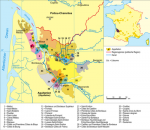Cordier en de redding van Bordeaux
 Bordeaux?
Bordeaux?
Bestaat dat dan nog? Bordeaux?
Does it still exist?
Yes, it does.
Not just or in particular ‘the elite’ with their exclusive image and behavior, but the much larger group of hard(er?) working ‘normal’ winemakers. Usually family businesses, not owned by an investment group, insurance company, banks or other, organizations focused on marketing and ‘return on investment’ in stead of passion and culture.
Whether you like it or not, that dubious Top 10 still gets the most attention. No matter how reprehensible their behavior is, they still serve a large crowd of people preserve the Grand Cru illusion. They do this mainly through emphasizing the pointless aspects of capitalism. Money, money and money, being expensive, more expensive, most expensive. Superficial and American, one could say, but remarkably, we see this behavior more often in (salon-) communists, Hindus and Muslims. It’s them who are the new emperors buying new clothes at incredible prices, ending up dressed in nothing but invincible marketing gowns.
Unfortunately, these buyers aren’t the only innocents that still believe in fairytales. Also the journaille is enjoying, drooling and eager to be, diligently, present at dinners that underline the pointlessness of the illusion. Soon we can read tweets, posts and blogs again, ‘live’ from the primeur-circus in Bordeaux. Some sound a cautionary note to the increasingly expensive bottles, in an attempt to buy off their guilt. They just mumble a Hail Mary and express their sincere regret and then go back to enslaving themselves again, with conviction, to several free Magnums (or larger), foie gras, lobster and caviar, everything of course under the guise of professionalism.
Whatever. I don’t feel comfortable with it and gladly dissociate myself from these practices. Even if that means no free glass of Latour, poured from a several-thousand-Euro’s costing carafe that was designed specifically for the occasion, as I had to read last year.
But to return to the subject: How’s Bordeaux doing? The entire world of wine is moving, but Bordeaux seems to remain motionless. Has everything been done in Bordeaux? I asked this question to David Bolzan, Directeur Général from Cordier – Mestrezat Grands Crus, who was visiting Holland to present a new line of wines from Cordier: The Club Elite.
Bolzan very first reaction: “Let me dream. Dream about how beautiful Bordeaux could be.” I swept a tear away and repeated the question. Bolzan continued. “I’ve been travelling for the las 20 years and I’ve visited all continents. I’ve found that Bordeaux as a concept is crumbling. It’s image is affected, the quality is under pressure, sales are reducing and competition is fierce. There are many fine wines, but only few brands and those became unaffordable. Midrange there are still many possibilities, but one has to establish himself. Without additional efforts the tide can’t be turned and Bordeaux will experience increasing problems. This was the motive to introduce the Club Elite, in our opinion the savior for the middle class wines from Bordeaux.
Cordier wants to offer the consumer what they can expect from Bordeaux: Quality. Besides that, Cordier wants to offer the producers what they need: Expertise in the fields of production and marketing, based on 125 years of experience and focused on the future. We’re not so much helping them with the product itself, because many of them are proving for years they’re very capable of making wine. It’s more about showing their qualities to the world, using our knowledge, experience and our connections.
Because of fierce competition is distinctiveness essential. The quality of the product needs to be high, of course, but also marketing it well is crucial. That’s why Cordier has developed a special bottle for a select number of estates, that enables them to clearly distinguish themselves.
Also new, innovative and distinctive is the box in which the bottles are sold. Not a crate that contains 12 or 6 bottles, but 4 bottles. In this way we meet the wish of our client, who prefers, under the present economical problematic circumstances, to buy a few bottles less, but still likes to show off with a crate; said Bolzan. “The 4-box concept also offers the opportunity to anticipate to specific wishes of clientele. There’s a version in varnished wood, in leather and even one that’s plated with 22 carat gold”. Yet more exclusive will be a box made from wood from a very special origin, something like a box made from the wood of the chestnut tree from Anne Frank. Really tipical John Doe….
More functional and less extreme is the attention paid to capsule, the label and the back tag, with the name Cordier in a subordinate role, by the way. The château itself is central, Cordier only facilitates. Every bottle is wrapped in paper and every crate is provided with a postcard containing a ‘personal’ message from the owner af the château; A subtle gesture that many seem to be receptive to. Especially for the Asian market there’s a crate for 8 bottles, because 8 happens to be their lucky number. In total the Club Elite includes 12 wines, from which 8 represent so called ‘Grand terroir’. The other 4 are named ‘Noblesse’ and are second wines from renowned châteaux. For sale purposes, Cordier provides special racks that emphasizes the presence of The Club Elite in wineshops even more.
The new concept is already available, but promotion is supposed to reign supreme during Vinexpo Asia-Pacific 2012 in Hong Kong. Then extensive attention will be paid to the 125-year anniversary of Cordier and Asia happens to be the most important market for Bordeaux.
The Club Elite consists of a series of 12 wines that vary in price from 100 to 200 Euro’s per 4 bottle-crate. Dutch importer Activin has so far selected 6 estates and those were recently comprehensively tasted in ‘Taste’ in The Hague.
Château La Rousselière Saint-Estephe, 2008
50% merlot, 40% Cabernet Sauvignon, 10% Cabernet Franc. Warm, almost balmy fragrance, open with mocha, toast and lots of merlot; nice rounded flavor, Merlot , Bordeaux and St. Estephe typicity is present. A little graphite in the finish but especially good juice despite a lean structure. Nice finale, not very pronounced, but friendly and drinkable, accessible and affordable.
Château Tour Massac, Margaux, 2009
64% Cabernet Sauvignon, 26% Merlot, 10% Cabernet Franc.
Powerful in the nose, compact, ripe black fruit, soft full start, youthful fruit, nice tannin structure, lots of cassis, the elegance of Margaux, decent wine, a lot of juice and very accessible with the right freshness
Clos Vieux Taillefer, Pomerol, 2009
100% Merlot. Nice full scent, velvety key, sweet, spicy with laurel and licorice, also mocha and tobacco, significantly more wood, underlying fruit tones; powerful and less accessible than the previous wines, but with the required quality
€ 180,00 for a 4-bottle case
Tour Sieujean Pauillac, 2009
85% Cabernet Sauvigon, 15% Merlot. In the nose clearly Cabernet Sauvignon, a lot of cassis and also ripe blackberries, almost creamy wood impression, smoky notes, ink, balsamico, graphite, but fruit is more important, in the start, strength, high acidity, tannin clearly palpable, firm development, a bit dry, clean finish. Bolzan praised his elegance and potential, although, in my opinion, that’s probably wishful thinking.
€ 172, 00 for a 4-bottle case
Château Pouget, Margaux, 2008
66% Cabernet Sauvignon, 30% Merlot, 4% Cabernet Franc.
Broad and deep fragrance, tobacco, leather, lots of black fruit, very ripe, blackberry jam, juicy in the mouth, rich, ripe, powerful without aggression, roundness, lovely fruit, good acidity, balance and length, ends with some wood, but the ripe fruit dominates, nice structure and great finesse, fine balance between power and elegance.
Chateau de Candale, Saint Emilion Grand Cru, 2009
84% Merlot, 14% Cabernet Franc, 2% Cabernet Sauvignon. First Year of new owner Jean-Louis Vicard (indeed, the one from the barriques). Domain of 12 ha, located in the southern part of St. Emilion, spread over 30 parcels with different terroirs. The winemaker Stephane Derenoncourt has chosen for this wine to be aged in 60% new French wood, of which 85% comes from Vicard.
More subdued aroma, underlying elegance, much refinement, length, beautiful fruit, lots of tension, warm glow, young, cedar, light licorice, beautiful black fruit, but also many red fruits. Wine with tension and potential, a classic on modern footing. Already presents itself well this year, but for the future expectations are higher.
David Bolzan is very capable, passionate, convinced and convincing and very commercial. People who know me, know I’m allergic to cheap marketing ploys, but understand and respect a good marketing philosophy and a sound sales policy. Sometimes I got jitters listening to the carefully selected statements made by Bolzan, but because of his relativistic sense of reality and a good sense of humor, a pleasant feeling remained when we said goodbye. One of the most important reasons for that was the mostly fine quality and fair price of the wines; that is, if you don’t buy for the cases, plated with (fools-) gold…
